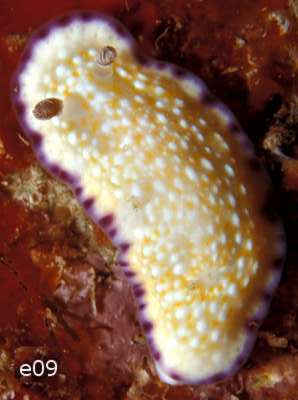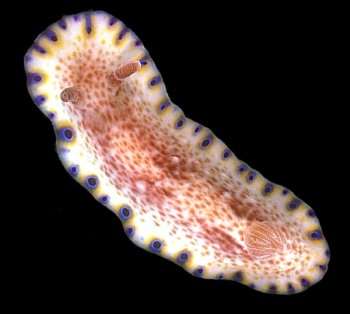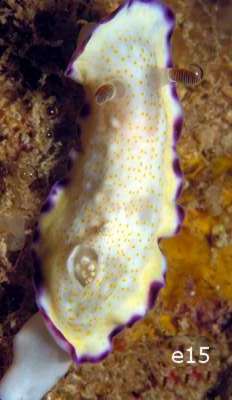White and yellow-spotted Hawaiian chromodorids
March 7, 2005
From: Bill Rudman

Scott Johnson's recent messages [see below] concerning this white and yellow-spotted group of chromodorids almost certainly suggest that 4 species of Chromodoris, C. aureopurpurea, C. alius, C. rufomaculata and C. albopustulosa are most probably colour forms of one species. This is an interesting example illustrating the problems facing taxonomists when they try to interpret old descriptions and the immense value in studying local faunas and local variation within a species in great detail.
Firstly let's look at the early names, seven of which I have posted copies of the original illustrations [see below]. Many early descriptions give brief features of the external shape and colour, and sometimes a coloured illustration (water colour) of varying quality. Sometimes the original specimens still exist in some museum, but they usually of little value at the species' level, and so we are left with trying to find little clues from the original descriptions. I have discussed some examples in a separate message [#13259 ].
If we look at C. albopustulosa [upper right] we see a form with a pale yellow background, darker yellow spots, and raised white pustules and a border with a pale purple band and spaced dark pueple spots. But from Scott Johnson's photos, this species can have a uniform yellow background, and the purple border can be broken into separate purple patches, each with a pale purple background and an intense purple spot. The photo of Chromodoris rufomaculata [lower right] shows a form in which yellow spots predominate on a mottled white background. However as Scott Johnson's photos show there is a continuum between this and typical C. albopustulosa, the white background in C. rufomaculata occurring when the white pustules of C. albopustulosa expand to replace the pale yellow background. In this species as well the purple margin is variable, sometimes entire sometimes broken. In both species the thinophore clubs are dark brown or purple with white edging, and the gills, which are held in a goblet shaped cluster, have opaque white edging. Scott Johnson reports these two 'species' mating in captivity [message #13190]. If we look at C. aureopurpurea [lower left] we see close similarities, and if we look at the variations in colour pattern reported for that species in the Forum we see a very similar continuum. Of particular interest are the purple spots around the mantle edge which in C. aureopurpurea are characterised by a dark purple spot on a lighter purple background and a yellow crescent shaped band at the inside edge. Many 'forms' of C. rufomaculata and C. albopustulosa have a yellow submarginal band just on the inside of their purple border which is almost certainly homologous to this yellow crescent. I proposed Chromodoris alius as an Indian Ocean species related to these other species. Scott Johnson's photos from the Marshall Ids would suggest that this is a form of C. albopustulosa in which the darker yellow spots are absent.
All forms have thinophore clubs which are dark brown or purple with white edging, and gills, which are held in a goblet shaped cluster, have opaque white edging. From my earlier work with this group, and Kay & Young's published descriptions, I can find no major anatomical differences between the species. Although I very much doubt it, it is still possible that one or more of these 'species' may be a very close mimic. What we clearly need to do is to build up more information on their biology, what their egg ribbons look like and what sponges do they feed on.
In the meantime I will add a note to the four Fact Sheets suggesting they may be all the same species
Best wishes,
Bill Rudman


Here are links to the relevant messages.
Original illustrations of:
Doris picta Pease 1860
Doris albopustulosa Pease 1860
Doris propinquata Pease 1860
Goniobranchus albomaculatus Pease 1866
Chromodoris rufomaculata Pease 1871
Doris prismatica var imperialis Pease 1860
Doris vibrata Pease 1860
Scott Johnson messages:
Chromodoris rufomaculata from the Marshall Islands
Chromodoris albopustulosa from the Marshall Islands
More Chromodoris albopustulosa from Hawaii
Chromodoris albopustulosa from Hawaii
Chromodoris alius? from Enewetak, Marshall Islands
Chromodoris alius? from Kwajalein, Marshall Islands
Chromodoris albopustulosa from Kure Atoll
References:
-
Kay, E. A., & Young, D.K. 1969. The Doridacea (Opisthobranchia; Mollusca) of the Hawaiian Islands. Pacific Science, 23(2):172-231.
-
Rudman, W. B. 1990a. The Chromodorididae (Opisthobranchia: Mollusca) of the Indo-West Pacific: further species of Glossodoris, Thorunna, and the Chromodoris aureomarginata colour group. Zoological Journal of the Linnean Society, 100(3): 263-326.
Related messages
-
Chromodoris albopustulosa from Maui
From: Philip A. Thomas, October 5, 2007 -
Chromodoris albopustulosa from Kure Atoll
From: Scott Johnson, March 7, 2005 -
Chromodoris alius? from Kwajalein, Marshall Islands
From: Scott Johnson, March 7, 2005 -
Chromodoris alius? from Enewetak, Marshall Islands
From: Scott Johnson, March 7, 2005 -
Chromodoris albopustulosa from Hawaii
From: Scott Johnson, March 7, 2005 -
More Chromodoris albopustulosa from Hawaii
From: Scott Johnson, March 7, 2005 -
Chromodoris albopustulosa from the Marshall Islands
From: Scott Johnson, March 7, 2005 -
Original illustration of Goniobranchus albomaculatus Pease 1866
From: Bill Rudman, March 7, 2005 -
Original illustrations of some Hawaiian chromodorids
From: Bill Rudman, March 7, 2005 -
Original illustration of Doris albopustulosa Pease 1860
From: Bill Rudman, March 7, 2005
